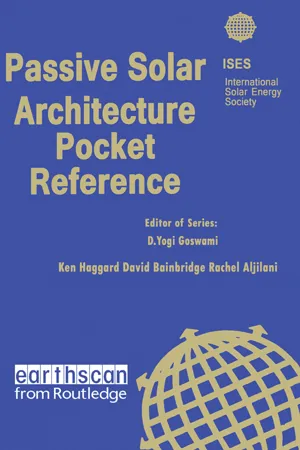
eBook - ePub
Passive Solar Architecture Pocket Reference
This is a test
- 94 pages
- English
- ePUB (mobile friendly)
- Available on iOS & Android
eBook - ePub
Passive Solar Architecture Pocket Reference
Book details
Book preview
Table of contents
Citations
About This Book
Our pocket reference books provide a wealth of practical information at your fingertips, whenever you need it. Rich in background detail, at-a-glance tables and diagrams, equations, and more, the Passive Solar Architecture Pocket Reference is a handy resource for architects, engineers and students.
Coverage includes:
- definitions
- load determinants and Responses (including world wide biomes and climates, building metabolism and response, thermal sources and sinks, passive building responses to sources and sinks, tuning the building to the environment, optimizing insulation & thermal mass for comfort)
- contextual aspects (including microclimate and siting, temperatures, humidity, wind, radiation and comfort parameters
- passive components (including building envelope, passive solar terminology, orientation, apertures and glazing, thermal storage, thermal control and materials
- design tools (including sun path diagrams, sun peg diagrams, air flow relationships, thermal modelling and life cycle design
- specific functions (including passive heating, passive cooling and ventilation, natural lighting, passive water heating, resource collection and integrated design).
Frequently asked questions
At the moment all of our mobile-responsive ePub books are available to download via the app. Most of our PDFs are also available to download and we're working on making the final remaining ones downloadable now. Learn more here.
Both plans give you full access to the library and all of Perlego’s features. The only differences are the price and subscription period: With the annual plan you’ll save around 30% compared to 12 months on the monthly plan.
We are an online textbook subscription service, where you can get access to an entire online library for less than the price of a single book per month. With over 1 million books across 1000+ topics, we’ve got you covered! Learn more here.
Look out for the read-aloud symbol on your next book to see if you can listen to it. The read-aloud tool reads text aloud for you, highlighting the text as it is being read. You can pause it, speed it up and slow it down. Learn more here.
Yes, you can access Passive Solar Architecture Pocket Reference by Ken Haggard, David A. Bainbridge, Rachel Aljilani in PDF and/or ePUB format, as well as other popular books in Architecture & Sustainability in Architecture. We have over one million books available in our catalogue for you to explore.
Information
SECTION 1: LOAD DETERMINANTS & RESPONSES: Worldwide Biomes & Climate
Passive solar architecture is also about reconnecting buildings to the uniqueness of place and climate. By doing this, we can build a better environment and reduce the cost and impacts of energy and resources used.

One useful tool is the context of biomes. A biome is an ecological community of plants and animals extending over a large natural area. Worldwide biomes repeat over different continents due to similar environmental patterns. The UN biosphere reserve program lists 15 different biomes as illustrated here. [33, 49]
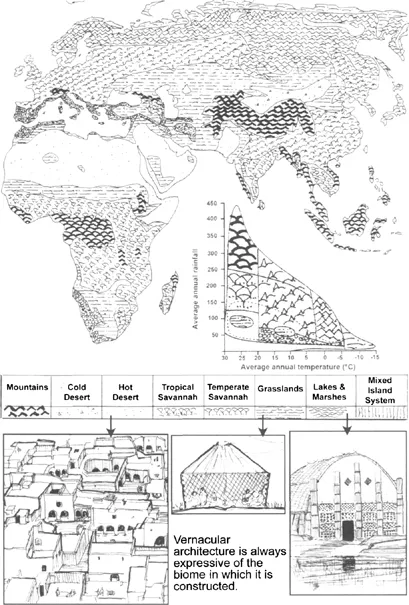
Thermal Sources [70]
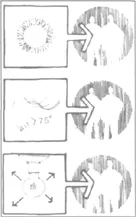
Solar Radiation
Solar radiation acts as a heat source for a building through direct, diffuse and reflected radiation. Diffuse radiation is the component of sunlight which reaches the ground after scattering and reflection by the earth’s atmosphere.
Outside Air
Outside air when it is warmer than about 24°C [75°F] can act as a heat source for most buildings.
Internal Metabolism
People, appliances, lights and cooking all add heat to the interior of a building and could be considered on-site heat sources
Thermal Sinks

Sky & Space
Some heat is always radiated from a building out to the sky. Under certain circumstances the upper atmosphere and space can act as an appreciable heat sink.
Outside Air
Outside air that is cooler than about 24°C [75 °F] can act as a heat sink. This is typically the case where nights are cool.
Wet Surfaces
Wet surfaces provide on-site sinks because heat is absorbed when water evaporates.

Sol-Air Temperature (Tsa)
The sol-air temperature is a fictitious, exterior air temperature, which would have the same effect on the building as the combined affects of the on-site sources and sinks which are acting on the building.
The difference between the sol-air temperature and the actual air temperature depends on many factors, including the strength of the solar radiation reaching the surface, the dew point of the air and the amount of wind. Other factors affecting sol-air temperature are related to the surface of the building, such as materials, colors and the ability of the surface of the building to radiate heat, particularly to the sky.
On a clear day in mid latitudes, the sol-air temperature range can be -1–49°C [30–120°F] while the actual air temperature range is 4–32°C [40–90°F].
Passive Responses to Sources & Sinks [70]
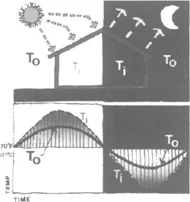
A light weight building or tin box with no insulation is the worst building method for climates with hot days and cold nights. During the day, the walls, roof and interior air temperature become greater than the outdoors, so it is hotter inside than outside. During the night, the walls, roof and interior air temperature fall below that of the outside air, making it colder inside than outside.

Well insulated lightweight construction, like a thermos bottle, reduces the heat gain and loss. This type of building can make our energy use more efficient, but will not optimize the interior environment. Heat gain and loss through windows and interior gains are not affected by the well insulated envelope. The interior will be too cold or too hot sometimes.
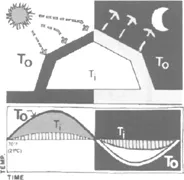
A heavy mass building will dampen the sol-air and actual temperature swings inside the building. The thermal mass in the structure will absorb heatduring the day and release it at night to warm the interior space. In an extreme mass building like an Egyptian pyramid, the interior temperature remains almost constant. For this reason, heavy mass buildings are indigenous to climates with an average sol-air temperature of 21 °C [70°F].
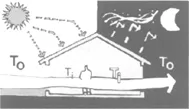
High mass buildings are not appr...
Table of contents
- Cover
- Title Page
- Table of Contents
- Copyright Page
- Definitions
- Section 1: Load Determinants & Responses
- Section 2: Contextual Aspects
- Section 3: Passive Components
- Section 4: Design Tools
- Section 5: Specific Functions
- References Cited references & resources by topic